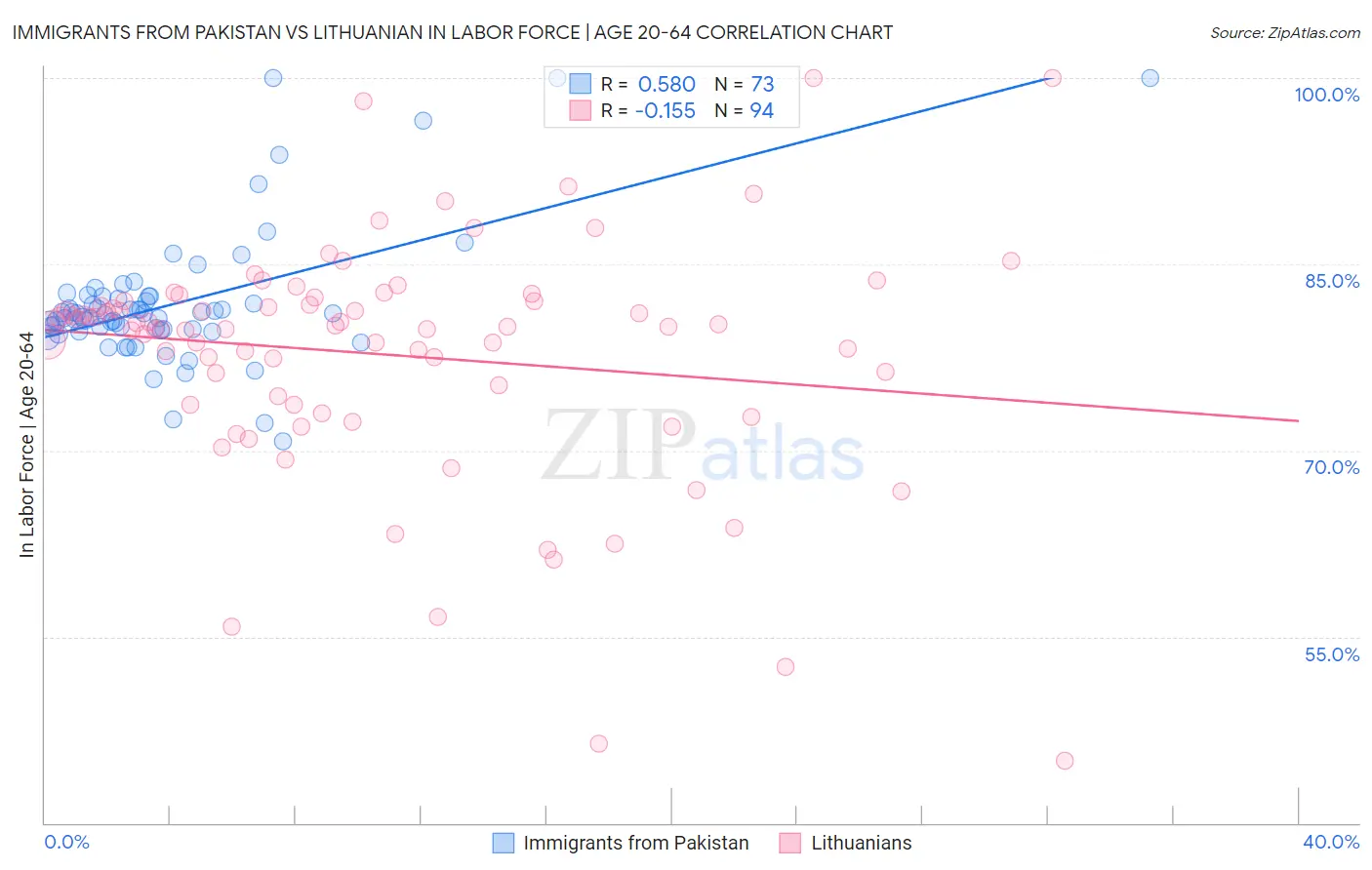Immigrants from Pakistan vs Lithuanian In Labor Force | Age 20-64
COMPARE
Immigrants from Pakistan
Lithuanian
In Labor Force | Age 20-64
In Labor Force | Age 20-64 Comparison
Immigrants from Pakistan
Lithuanians
80.5%
IN LABOR FORCE | AGE 20-64
99.6/ 100
METRIC RATING
46th/ 347
METRIC RANK
80.2%
IN LABOR FORCE | AGE 20-64
98.7/ 100
METRIC RATING
65th/ 347
METRIC RANK
Immigrants from Pakistan vs Lithuanian In Labor Force | Age 20-64 Correlation Chart
The statistical analysis conducted on geographies consisting of 283,910,968 people shows a substantial positive correlation between the proportion of Immigrants from Pakistan and labor force participation rate among population between the ages 20 and 64 in the United States with a correlation coefficient (R) of 0.580 and weighted average of 80.5%. Similarly, the statistical analysis conducted on geographies consisting of 421,962,111 people shows a poor negative correlation between the proportion of Lithuanians and labor force participation rate among population between the ages 20 and 64 in the United States with a correlation coefficient (R) of -0.155 and weighted average of 80.2%, a difference of 0.27%.

In Labor Force | Age 20-64 Correlation Summary
| Measurement | Immigrants from Pakistan | Lithuanian |
| Minimum | 70.7% | 45.0% |
| Maximum | 100.0% | 100.0% |
| Range | 29.3% | 55.0% |
| Mean | 81.8% | 77.7% |
| Median | 80.9% | 80.0% |
| Interquartile 25% (IQ1) | 79.7% | 73.7% |
| Interquartile 75% (IQ3) | 82.4% | 82.0% |
| Interquartile Range (IQR) | 2.7% | 8.3% |
| Standard Deviation (Sample) | 5.4% | 9.6% |
| Standard Deviation (Population) | 5.4% | 9.5% |
Demographics Similar to Immigrants from Pakistan and Lithuanians by In Labor Force | Age 20-64
In terms of in labor force | age 20-64, the demographic groups most similar to Immigrants from Pakistan are Slovene (80.5%, a difference of 0.010%), Immigrants from Africa (80.4%, a difference of 0.040%), Immigrants from Hong Kong (80.4%, a difference of 0.060%), Immigrants from Greece (80.4%, a difference of 0.090%), and Immigrants from Sudan (80.4%, a difference of 0.11%). Similarly, the demographic groups most similar to Lithuanians are Immigrants from Korea (80.3%, a difference of 0.010%), Immigrants from Albania (80.3%, a difference of 0.010%), Carpatho Rusyn (80.3%, a difference of 0.020%), Serbian (80.3%, a difference of 0.030%), and Swedish (80.3%, a difference of 0.030%).
| Demographics | Rating | Rank | In Labor Force | Age 20-64 |
| Slovenes | 99.7 /100 | #45 | Exceptional 80.5% |
| Immigrants | Pakistan | 99.6 /100 | #46 | Exceptional 80.5% |
| Immigrants | Africa | 99.6 /100 | #47 | Exceptional 80.4% |
| Immigrants | Hong Kong | 99.5 /100 | #48 | Exceptional 80.4% |
| Immigrants | Greece | 99.4 /100 | #49 | Exceptional 80.4% |
| Immigrants | Sudan | 99.4 /100 | #50 | Exceptional 80.4% |
| Immigrants | Sri Lanka | 99.3 /100 | #51 | Exceptional 80.4% |
| Turks | 99.2 /100 | #52 | Exceptional 80.3% |
| Immigrants | Peru | 99.2 /100 | #53 | Exceptional 80.3% |
| Peruvians | 99.1 /100 | #54 | Exceptional 80.3% |
| Immigrants | Cabo Verde | 99.0 /100 | #55 | Exceptional 80.3% |
| Immigrants | Northern Africa | 99.0 /100 | #56 | Exceptional 80.3% |
| Afghans | 98.9 /100 | #57 | Exceptional 80.3% |
| Serbians | 98.9 /100 | #58 | Exceptional 80.3% |
| Swedes | 98.9 /100 | #59 | Exceptional 80.3% |
| Tongans | 98.8 /100 | #60 | Exceptional 80.3% |
| Burmese | 98.8 /100 | #61 | Exceptional 80.3% |
| Carpatho Rusyns | 98.8 /100 | #62 | Exceptional 80.3% |
| Immigrants | Korea | 98.8 /100 | #63 | Exceptional 80.3% |
| Immigrants | Albania | 98.7 /100 | #64 | Exceptional 80.3% |
| Lithuanians | 98.7 /100 | #65 | Exceptional 80.2% |